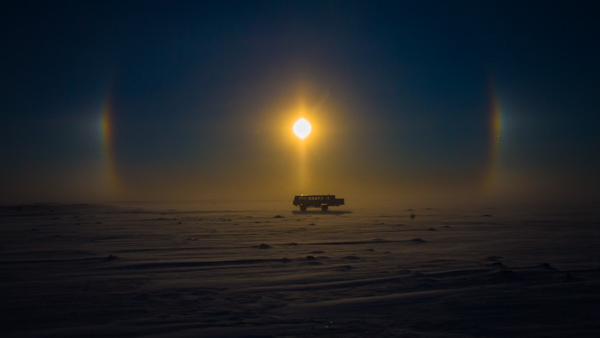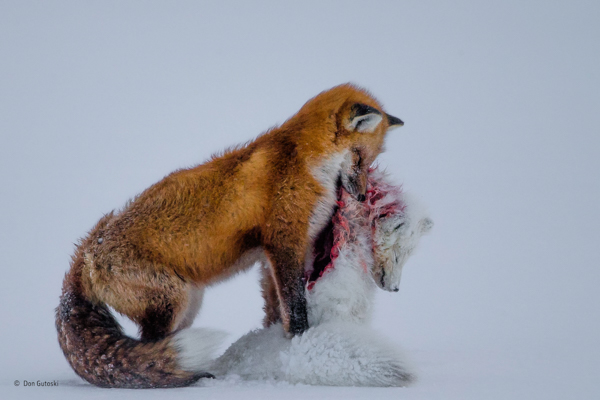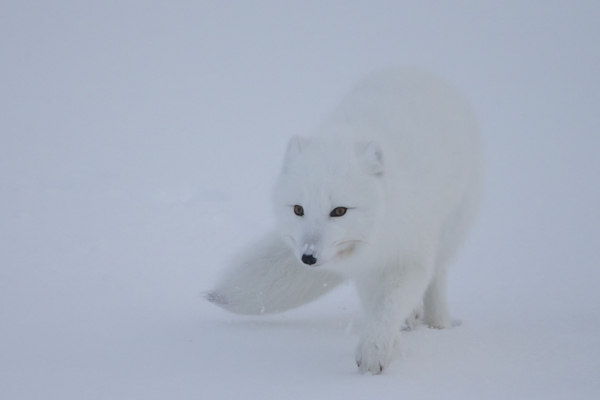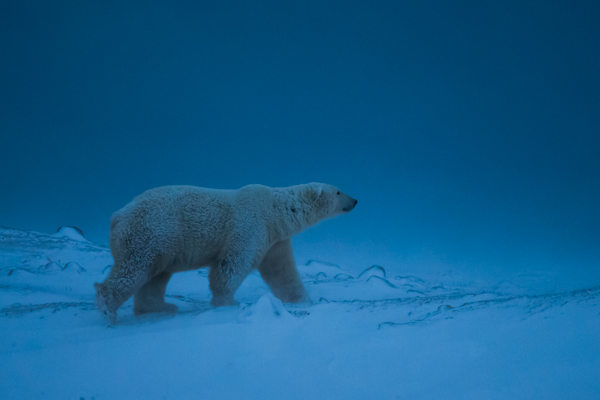WPY - The Proof is in the Picture

Guest Blog written by Environmental Visual Communication student Kendra Marjerrison
Looking out the eight-foot-high windows of the Tundra Buggy traversing Wapusk National Park, Don Gutoski waited for signs of life.
The guide noticed it first - a red fox moving across the snowy expanse of tundra. With his finger resting a hair-trigger away from the camera’s shutter release button, Don and a group of fellow photographers and guides moved closer. One hundred feet away from the red fox they realized it had been on the hunt. Its meal - an Arctic fox. The shutter of Don’s camera opened and closed, again and again capturing nearly 2,000 pictures that cold afternoon.
For some wildlife photographers, a kill shot is the ultimate goal. It creates compelling photographs that highlight moments people don’t often get to see. For others, it’s a difficult scene to witness from behind the lens. Don, the 2015 Wildlife Photographer of the Year, had no idea that the predatory behaviour captured in the photograph he took on the last day of his northern adventure would be more than just an interesting shot. It’s a powerful story about what can happen when the Earth becomes warmer and two competing predators, the red fox and the Arctic fox, are driven to cross paths.

The tundra of Wapusk National Park at Cape Churchill, Manitoba is home to both the red fox and the native Arctic fox. Scientists are beginning to examine the potential northward expanding range of the red fox in Canada, the role the warming climate may play in it, and how this could impact the Arctic fox. Don’s photo reveals that in Cape Churchill Manitoba, the more aggressive and larger red fox not only outcompetes the Arctic fox, but consumes them as prey - a behaviour that has rarely been documented in the past. As the range of the two fox species increasingly overlaps over the globe, the pressure on the Arctic fox will continue to grow.

Don shared his amazing story with ROM in an interview about the power of wildlife photography and his award-winning image:
Q: What techniques or methods do you use as a wildlife photographer and what are you searching for in an effective picture?
Tough to answer. Really I'm just trying to document the natural world with images that are unusual and special to me. That's my challenge. As an amateur it's really a personal challenge. I often look at a picture as being good based on the difficulty of finding the subject and the difficulty of recording something that is unique. I never know what a good picture is until I see it. I often have ideas about the "type" of image I want to get, but most often the "special" images I get on a trip are completely unpredictable.
Q: Can you talk about what brought you to that moment in your winning photograph?
Persistence! In a word. I'm serious about my hobby. And if there's something to photograph, I'll be out there shooting until the light goes. We watched the red fox feeding for several hours, resting and then when it picked up the remains to "cache" for later, I continued to shoot and came up with this image. This was a totally unexpected image, and I didn't realize how good it was until I saw it on my laptop screen later that night.
Q: Had you done fox photography and background research on them previously? Did you know the implications of what you were seeing when you took your photo?
No! I've taken a few cute red fox pictures and some arctic fox photos on previous northern trips. It wasn't until we saw this event that talk amongst the guides revealed that no one had seen or recorded this event before. The fact that global warming likely played a role was only discovered later. You know when the guides are excited about something you see that it’s important. Extensive research in Churchill shows that if warming continues at the rate it has for the past 30 years that polar bears will be gone from that region in 25 years or less.
Q: Did you know when you took your winning photo that you had ‘the one’?
When I saw it later, I knew it was a very special image. I never dreamed it would be "the one" however. I was shooting high speed and the shot before and after just don't compare. This pose was literally less than one second, a stop-in-time moment.
Q: How has it felt winning WPY and what does it and your photo mean for you?
I've been overwhelmed at the attention I've received and even more by the worldwide coverage the contest and the photo have generated. This award is the highest honour I could ever receive and affirms that my work is at the highest level.
Q: What have you seen or heard in response to this picture that really highlights the need for engaging scientific communication?
I think the impact of the image and the message it's sending should be used as a symbol for climate change and the need to act now. I would love someone (like you) to promote this image and the message to our new government. Trudeau has already stated he wants to act on climate change. This could be a symbol for the need to act. It is a powerful image and people really react to it. This is a chance to do something.
Q: Do you have any advice for the regular Joe who picks up a camera?
People take pictures. It's work to take "photographs". That's true with any endeavour. It's a fantastic hobby that can be enjoyed close to home or anywhere in the world. The limits are only what you put on it. The photos in this year's exhibit really show the talent and creativity of the photographers who are recognized. Read their stories. I learn each year when I view this display of international talent.
Q: What’s next for you?
Madagascar. I'm always planning new trips and locations. I am going with my wife and a guide to take photographs of lemurs.
Q: Is there anything else you would like to say to ROM readers?
Enjoy this exhibit. It's wonderful. And speak up for wildlife when you can.

The effects of climate change in Northern Canada aren’t limited to the decline of one species or to the loss of ice. The web of intricate relationships that make up the Arctic ecosystem - from animals to plants to ice – is being threatened. It’s like a weaving trail of dominos; if you knock over just one domino, or remove a single species, it can create a reaction that ripples through an entire ecosystem.
That’s why Don’s photograph is so important. With its haunting beauty, it reminds us that we need to pay attention to the tiny ripples already spreading out around us, so that research and funding can be directed where they are needed most. It also shows how powerful wildlife photography and citizen science can be in adding to the body of science knowledge.
Don originally set out to photograph polar bears on his trip to Cape Churchill, Manitoba, but instead he achieved something all photographers strive for. He captured a story. He captured the tale of two foxes.
Don’s winning photograph, “The Tale of Two Foxes”, can be seen at the 2015 Wildlife Photographer of the Year (WPY) exhibit at the Royal Ontario Museum. Come check it out, along with 99 other new, amazing photographs that are shining a light on our natural world.
